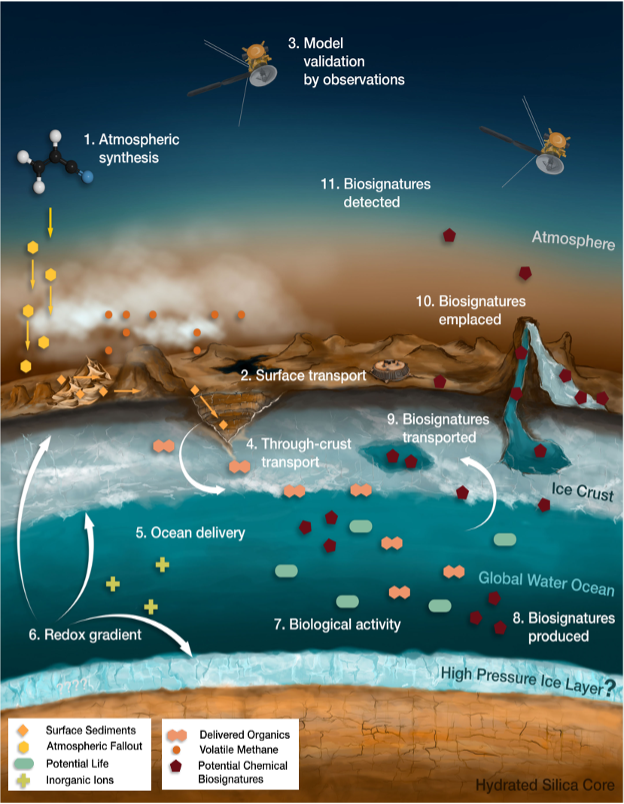The Habitability of Hydrocarbon Words: Titan and Beyond
- 1Jet Propulsion Laboratory, Division for Earth and Space Sciences, Pasadena, United States of America (rosaly.m.lopes@jpl.nasa.gov)
- 2Department of Earth and Environmental Sciences, College of Liberal Arts and Sciences, University of Illinois at Chicago, United States
- 3Hawai‘i Institute of Geophysics and Planetology, University of Hawai‘i, Honolulu, HI, USA
- *A full list of authors appears at the end of the abstract
Titan is an ocean world, an icy world, and an organic world. We consider that Titan’s subsurface ocean and ductile ice are the most likely habitable environments on the moon. The ocean may be in contact with an organic-rich ice-rock core, potentially providing redox gradients, heavier elements, and organic building blocks critical for a habitable environment. Titan’s abundant surface organics could be delivered to the aqueous environment through processes such as impact cratering and potential convective cycles in the ice shell. Our work investigates the pathways for atmospheric organic products to be transported from the surface to the ocean/core and the potential for ocean/deep ice biosignatures and organisms to be transported to the shallow crust or surface for interrogation and discovery. Our overarching goal is to characterize the habitable environments on Titan and identify their potential biosignatures. We will present a summary of the work conducted by the team to date, which focuses on the following objectives: (i) Determine the pathways for organic materials to be transported (and modified) from the atmosphere to surface and eventually to the subsurface ocean (the most likely habitable environment). (ii) Determine whether the physical and chemical processes in the ocean create stable, habitable environments. (iii) Determine what biosignatures would be produced if the ocean is inhabited. (iv) Determine how biosignatures can be transported from the ocean to the surface and atmosphere and be recognizable at the surface and in the atmosphere.
Figure: Titan’s potential geochemical pathways for organic materials to go from atmosphere to surface and ocean, and for extant chemical biosignatures to go up from the potentially habitable ocean to the surface and atmosphere.

Acknowledgments: Part of this work was carried out at the Jet Propulsion Laboratory, California Institute of Technology, under contract with NASA. This work was funded by NASA’s Astrobiology Institute grant NNN13D485T.
PI: Rosaly Lopes, Deputy PI: Michael Malaska Co-Is: J. Michael Brown (U of Washington), Sarah Fagents (U of Hawaii), Chris Glein (SwRI), Alex Hayes (Cornell U), Rob Hodyss (JPL/Caltech), Paul Johnson (JPL), Fabien Kenig (U of Illinois, Chicago), D’Arcy Meyer-Dombard (U of Illinois, Chicago), Claire Newman (Aeolis Research), Conor Nixon (NASA GSFC), Florian Schwandner (NASA Ames), Anezina Solomonidou (Hellenic Space Center), Christophe Sotin (University of Nantes), Sugata Tan (Planetary Science Institute), Steve Vance (JPL/Caltech), Karen Willacy (JPL/Caltech) Collaborators: Jack Beauchamp (Caltech), Sam Birch (Brown University), Olivier Bollengier (U. of Nantes, France), Mark Boryta (Mount San Antonio College), Gwen Brouwer (U of Hawaii), Liliane Burkhard (U of Hawaii), Morgan Cable (JPL/Caltech), Martin Cordiner (GSFC), Alvaro P. Crosta (Campinas U., Brazil), Mohit M. Daswani (JPL/Caltech), Edith Fayolle (JPL/Caltech), Pat Irwin (Oxford University, UK), Baptiste Journaux (U of Washington), Jeff Kargel (U of Arizona), Klara Kalousova (Charles U, Prague), Nick Lombardo (Yale U), Marika Leitner (Cornell U.), Jonathan Lunine (Cornell U.), Judy Malas (U. Illinois), Kelly Miller (SWRI), Ashley Schoenfeld (JPL/Caltech), Ingo Mueller-Wodarg (Imperial College London, UK), Laureen Schurmeier (U of Hawaii), Benoit Seignovert (JPL), Elizabeth Silber (Western U., London, Canada), Brendan Steffans (Florida Institute of Technology), Nick Teanby (U of Bristol, UK), Alexis Templeton (U of Colorado), Alexander Thelen (GSFC), Orkan Umurhan (SETI), V. Vuitton (U of Grenoble Alpes, France), Yuk Yung (Caltech)
How to cite: Lopes, R., Malaska, M., Steven, V., Darcy, M.-D., and Fagents, S. and the Titan NAI Team: The Habitability of Hydrocarbon Words: Titan and Beyond, Europlanet Science Congress 2024, Berlin, Germany, 8–13 Sep 2024, EPSC2024-6, https://doi.org/10.5194/epsc2024-6, 2024.